Menus
- Mid-range travel enduro checked
- Yamaha with Tenere tradition
- Slim, wiry, no gimmicks
- Disc not adjustable
- How does it look in the field?
- Drive identical to that of the MT-07
- Conclusion
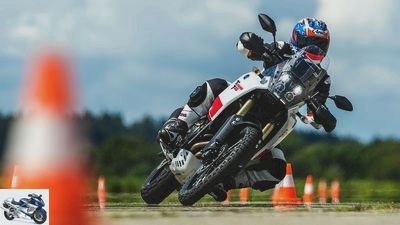
Arturo Rivas
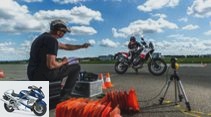
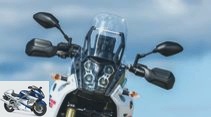
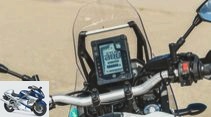
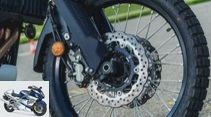
21st photos
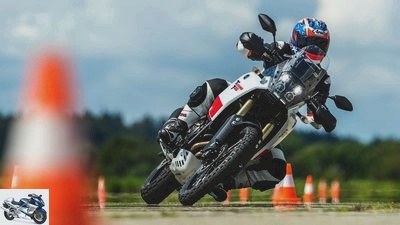
Arturo Rivas
1/21
The long-awaited and long-awaited Tenere 700 is finally here.
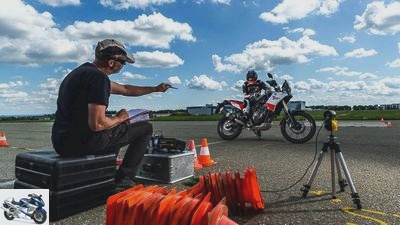
Arturo Rivas
2/21
Burning fast times on asphalt was not at the top of the specifications. But the Yamaha can do that too.
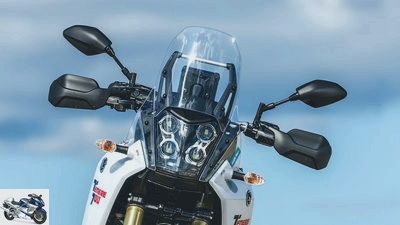
Arturo Rivas
3/21
The windshield is high, narrow, not adjustable and difficult to clean from the inside. The LED lamps exude a powerful rally flair.
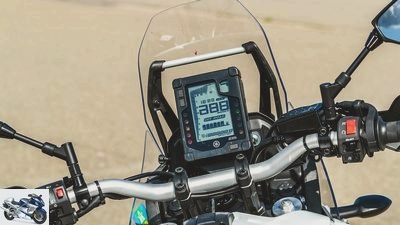
Arturo Rivas
4/21
The display is not particularly easy to read.
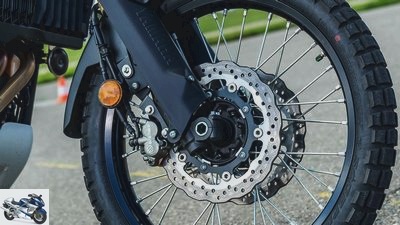
Arturo Rivas
5/21
Stable double disc with inexpensive floating saddles. The production tire sets the limit on asphalt.
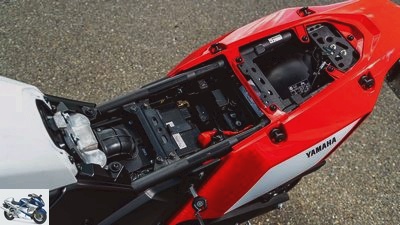
Arturo Rivas
6/21
The battery and air filter are easily accessible under the two-part seat.
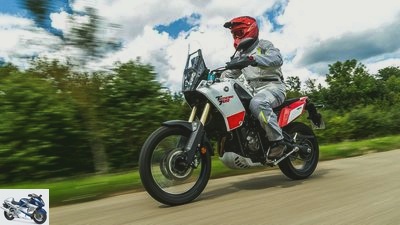
Arturo Rivas
7/21
The bench is narrow, hard and as comfortable as it looks.
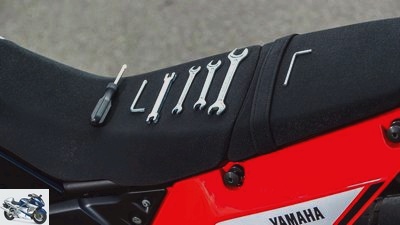
Arturo Rivas
8/21
The on-board tools, even with a spoke wrench, are considered extensive these days. But it is not enough to loosen the rear axle for the purpose of tensioning the chain or removing the wheel.
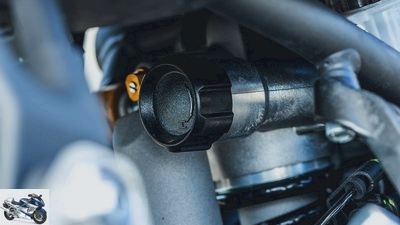
Arturo Rivas
9/21
The spring preload is easily adjusted using the handwheel.
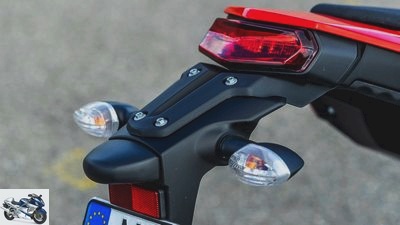
Arturo Rivas
10/21
The license plate holder can easily be removed for serious off-road use. The (sports) license plate is then placed on the remaining stump.

Arturo Rivas
11/21
The hand protectors, together with their thin sheet metal holder, look very frugal and of little value. They do not match the otherwise quite robust overall impression of the Tenere.

Arturo Rivas
12/21
44.9 meters braking distance. Here the studded tires are the limiting factor.
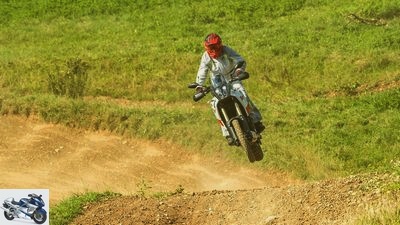
Arturo Rivas
13/21
Fly, bird, fly! Moved by an expert hand, the Yamaha is capable of making deposits on the other side of the road that would not necessarily have been bet on.
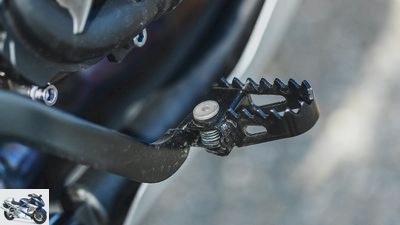
Arturo Rivas
14/21
Foot brake lever: Jagged and foldable like its colleague to the left of the motor housing. In this way, they remain intact in the event of involuntary and not always avoidable ground contact in the area.
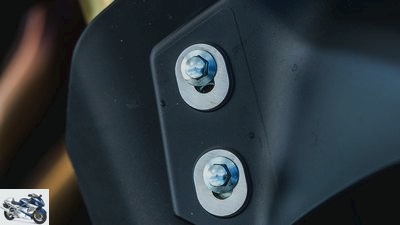
Arturo Rivas
15/21
Mudguard: For better freedom of movement of the front wheel on muddy ground, the height of the mudguard can be adjusted by seven millimeters. Sounds like little, but brings a lot.
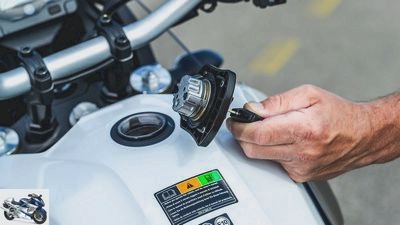
Arturo Rivas
16/21
Perhaps, somewhere in the world, there is an advantage if you can put the cap down for refueling. In the local part it is rather annoying to have to do this. And it’s not up to date either.
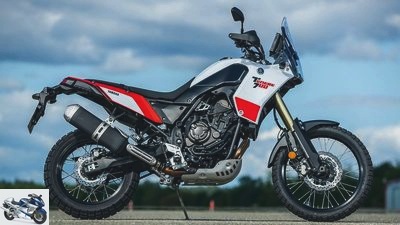
Arturo Rivas
17/21
The water-cooled two-cylinder four-stroke in-line engine develops 73 hp.
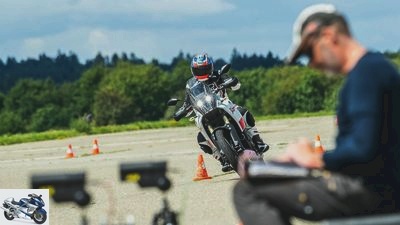
Arturo Rivas
18/21
Despite the 21-inch front wheel and slightly cluttered tires, the Tenere scurries faster around the pylons at 108.1 km / h than the 2014 MT-07.
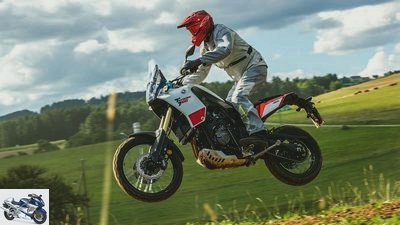
Arturo Rivas
19/21
The table, which the Tenere flies over with absolute calm, measures around 15 meters.
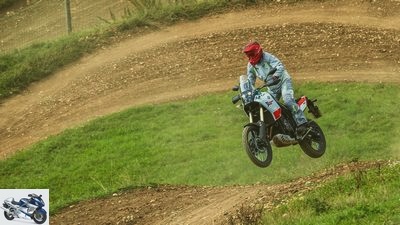
Arturo Rivas
20/21
In the price-performance rating, the Tenere achieved a 1.3.
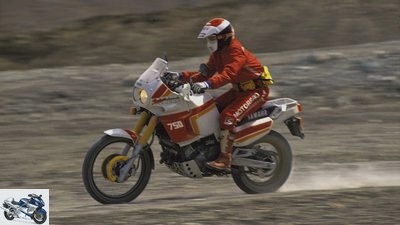
Arturo Rivas
21/21
1989 came the first two-cylinder Tenere. It was much closer to today’s travel enduros than a halfway serious off-road bike. It was simply too heavy for that.
Yamaha Tenere 700 in the top test
Mid-range travel enduro checked
The long-awaited and long-awaited Yamaha Tenere 700 is finally here. In order to check whether what would last so long is actually good, we immediately asked the twin to dance for the top test pylons. Hossa!
Old legends never die “(” Old legends never die “) is on the one hand a truism. On the other hand, the truthfulness of this rush is currently well documented, as can be seen from the excitement of the two-wheeler scene in view of the introduction of the current one Yamaha Tenere 700 is easy to read. After all, the name, which in the Tuareg language means “land out there” and designates a sandy desert in the north of Niger, has a reputation for long-distance, desert or other adventure travelers like Donnerhall.
Buy complete article
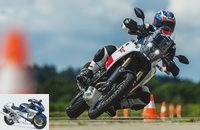
Yamaha Tenere 700 in the top test
Humba Humba, Tenere
Off-road all-rounder returns
This was founded in 1983 with the XT 600 Tenere, model code 34L. It looked very similar to the official desert racers with its large 28-liter tank and long suspension travel (v / h 255/235 mm) and was considered relatively light at 168 kilograms. Due to its extraordinary reliability, it quickly developed into the quasi-standard vehicle of the scene. Over the years, the 600 series was domesticated more and more, which was advantageous in everyday life, but increasingly limited its off-road qualities.
The water-cooled XTZ 660 presented in 1991 still had the desert name, but was what would be called a soft enduro today. It was even worse with the two-cylinder XTZ 750 Super Tenere presented in 1989, which was optically based on the factory racers, but never really had anything to do with the terrain. Yamaha seemed to have lost interest in this segment, which is also evidenced by the fact that there are no Teneres at all on an official model history table between 1996 and 2008. The reputation, however, remained.
Yamaha with Tenere tradition
It wasn’t until 2008 that Yamaha re-entered the travel enduro stage with the XT 660 Z Tenere, and everything could have been fine. But the environment had changed. The 660 was considered cheap, but also too weak, too heavy and, above all, too single-cylinder. At least in this country she led a largely unnoticed existence. Only the following should be said about the XT 1200 Z Super Tenere, which has been available since 2010: Weight with a full tank 269 kilograms! It is of course a comfortable and reliable touring motorcycle, even with bad road qualities, but one thing it is definitely not: an enduro. The reputation, however, remained.
Arturo Rivas
The engine has an output of 73 hp.
It’s unclear whether they watched the very old Dakar films at Yamaha and then said we needed a bike like this again, or whether they heard the other call. The reputation of those who do not want to be ridden by their motorcycles, but rather hold the reins themselves. Who are wondering what to do with three-digit horsepower figures when their grip and sometimes their own abilities can easily reach their limits under the appropriate conditions. How do you get ahead when a sensor has hiccups somewhere in the middle of nowhere and the next OBD reader is several days away? And, not entirely unimportant, whose budget simply does not allow prices deep in the five-digit range.
Slim, wiry, no gimmicks
Yamaha has found a slim but towering answer to all of these questions. The final formulation of this answer was a bit drawn in the end, because the production bike is not only visually different from the prototype that MOTORRAD was allowed to ride for a short time in 2017. But the concept remained largely: slim, wiry, no gimmicks and not too many compromises. So the seat height of 880 millimeters is already difficult in the direction of dwarf death, but therefore sacrificing some spring travel (f / r 210/200 millimeters)? No way. After all, the accessories include a lower seat and a lowering kit. There is also a higher bench, by the way, so that you don’t have to walk that long when you get up. Once you have climbed the hard and narrow seat and maneuvered the twin from the noble-looking aluminum side stand into a vertical position, the eye falls on the monochrome LCD cockpit, reminiscent of an old game console. In addition to the at best moderate readability, it is particularly noticeable that luminous or reflective strips on the chest of the protective clothing tend to be reflected in the cockpit.
MOTORRAD Podcast – Curve Discussion
In addition to speed, engine speed, outside and engine temperature, it shows the current and average consumption. It offers two trip counters and a counter called Trip CD, which counts down from a freely enterable three-digit number to zero. Whatever this feature can be used for. What you could use, however, would be a useful fuel gauge. At least with the test motorcycle, nothing happens for the first 100 kilometers after filling up with the tank, on the following 150 kilometers the blocks disappear in quick succession and the last one flashes. Quite inconspicuous so that it can easily be overlooked – especially in daylight. If you then fill up immediately, just twelve of the specified 16 liters go in. So you get to the bottom of the matter. Equipped with an emergency ration of fuel in the backpack, it is time to run the tank dry. But after 80 (!) Kilometers of continuous flashing – another counter shows the distance driven on reserve – the external circumstances, keyword: motorway construction site without hard shoulder, make refueling seem extremely advisable. 1.7 liters were still there, which would have been enough for around 50 kilometers. Because the Twin 3.7 liters are enough for the standard distance. To show around a third of the range as a reserve appears to the author to be a bit overly cautious, but perhaps this is an isolated case. One last word on the subject of the cockpit: The speedometer is ahead of the curve, over 100 km / h and more, that is to say, speedometer 130 only corresponds to a real 120 km / h. At the real Vmax of 186 km / h, the device can even be carried away to a two on the display.
Disc not adjustable
Highway chases are not exactly what the 700 series was developed for, but they go along with it without complaint. The straight-line stability is stable, even deliberately introduced interference pulses quickly subside. Behind the high, but narrow and non-adjustable screen, it does get quite loud, but it offers so much wind protection that you can drive with at least half-open visor even at high speeds. A relief in the heat. The chassis also loves high speeds. In line with the rally look, the fully adjustable shock absorber with firm damping is the main thing. Initially, the response at a moderate speed was a bit rough, but two clicks on the cushioning removed the comfort noticeably. Unfortunately, the screw for the compression adjustment is not really easy to reach. In contrast to the adjustment of the spring base, which can be easily done using a handwheel. The 43er Kayaba upside-down fork is a bit more binding. It responds excellently and irons away any unevenness without appearing limp.
Arturo Rivas
The LED lighting exudes the charm of a rally motorcycle.
So, now down from the train and across country roads of various qualities to the test area, where, at this point, the first driving impression will be confirmed. One thing in advance: the Yamaha is on Pirelli Scorpion Rally STR tires, front with special code “A” in the widespread 21/18 inch combination. As it should be for an enduro, these are relatively rough. And anyone who knows coarse tires knows that they don’t always make the best impression on the road. So you have not set too high a horizon of expectations and after a few corners you are pleasantly disappointed. Even its sister, the MT-07, is a nimble curve robber, but the Tenere turns in even more lightly, but remains more stable in an inclined position. The narrow tire width at the front and the large rim diameter come into play here. However, it takes a while to get the enduro look of the tires out of your head and really trust the grip. But don’t overdo it, the limit area is high, as the times on the course show, but it is narrow. If the rubbers get too much, the bike pushes both wheels in the direction of the discounts. Even the Pirellis cannot perform magic, as the only moderate delay values show. The high negative proportion of the profile and the walking blocks simply set physical limits here. If you only ride on asphalt and can do without the three-day beard look, you can simply put other rubbers on the rims. Incidentally, they are equipped with hoses, which makes assembly far away from the corresponding machines much easier.
How does it look in the field?
Since colleague Rolf Henniges and all the other colleagues who were allowed to attend the presentation of the twin raved about the extensively enjoyed off-road properties, a review of these statements was inevitable. Since the visit to a suitable desert, especially not the one that gave it its name, could not be integrated into the time or budget, we asked for asylum during free practice on a small but nice private motocross track near the test site. Under the knowledgeable hands of ex-World Cup crosser Peter Mayer, the Yamaha didn’t get in the way of all the EXCs and Co., and after just a few laps the 15-meter long table filled up without any problems. While the rear shock absorbed this load unmoved, the fork reached its limits on landing, but with a few clicks of more compression damping it also mastered the test to everyone’s satisfaction.
Arturo Rivas
The Tenere also cuts a fine figure off-road.
After the short but intense interlude, Peter said he could hardly wait for an off-road comparison with the KTM 790 Adventure R, and the R is important at this point. Because the result is by no means certain. Back on the road again, the sun slowly disappears behind the horizon and night falls. Now the four martial-looking LED lamps can show what they can do. In the dark, the Yamaha pushes a beam of light in front of it, reminiscent of a salad bowl filled to the brim with quark. Although this is very bright and evenly illuminated, it has a hard light-dark border. Since the cladding is fixed to the frame, the lamps always shine straight ahead. As long as it goes somewhat in this direction, everything is so far in order. But as soon as the road becomes more curvy, the picture changes. Because the more lean the motorcycle travels, the more the edge of the light cone on the inside of the curve moves in the direction of the front wheel. That sounds good at first, but it isn’t, because that’s how the dark part moves towards the motorcycle. It’s basically the opposite of cornering lights. The high beam, in turn, which is switched on to the low beam, adds a beam of light shining far forward to the salad bowl.
Drive identical to that of the MT-07
So far we haven’t said too many words about the drive. It is identical to that of the MT-07 and is a real joy here and there. Due to the different supply and disposal routes compared to the MT, the twin with its 270-degree crankshaft is said to have gained some steam in the medium speed range. However, this was not confirmed on the test bench. But it doesn’t matter. Because it also responds well, has a linear power delivery and is easy to turn. In addition, it is so elastic that you can start off in fourth gear without any problems. Which is occasionally necessary, because if you start to downshift too late while stopping, the gears can get tangled up. And this gearbox doesn’t like shifting while stationary.
Arturo Rivas
The display revealed minor weaknesses in the test.
The switch box works fine upwards. The cable-operated clutch with non-adjustable hand lever can be easily operated with two fingers, finely dosed and only tends to pluck a little after a cold start in the morning. The secondary transmission has been adapted to the 18-inch rear wheel, but is still a tad longer than the MT-07. In contrast to the Tenere, this one never missed seventh gear on the autobahn. For whatever reason. Time for a little resume: 36 years after the first Tenere, the circle can be seen as closed, even though the new one, apart from the silhouette, has nothing to do with a Dakar racer. They have been driving 450 single-cylinder engines there for several years. Nevertheless, the new Tenere pretty much matches the spirit of the old one. Even if it took a long time: the call was answered. The legend can go on.
Conclusion
Yamaha has had a really good feel for the market for a number of years, see MT-07 and MT-09. The demand for the Tenere also shows that there is a market for vehicles that concentrate on the essentials and simply omit everything that does not serve the actual purpose of driving, even off-road. It is not yet perfect, but still a great achievement. Chapeau!
Related articles
-
Yamaha MT-07 model year 2017 and 2018 test
Arturo Rivas 16 photos Arturo Rivas 1/16 The Yamaha MT-07 models from 2017 and 2018 in a comparison test. Arturo Rivas 2/16 2018: The damper was tuned…
-
Top test: Yamaha XT 1200 Z Super Tenere
Bilski 23 photos Yamaha 1/23 The wheel speed sensors for ABS and traction control receive their signals from radially mounted rings. Yamaha 2/23 In the…
-
Test of the Honda XR 600 R against the Yamaha TT 600 R
Yamaha TT 600 R. Comparison test, Honda XR 600 R, Yamaha TT 600 R Honda XR 600 R versus Yamaha TT 600 R Does it really have to be state-of-the-art,…
-
Comparison test: Honda Varadero 125, Kawasaki KMX 125, MZ 125 SX, Yamaha TDR 125
Comparison test: Honda Varadero 125, Kawasaki KMX 125, MZ 125 SX, Yamaha TDR 125 The upper floors Power from the cellar cannot be made with a…
-
Yamaha XT 600 Tenere – XT 660 Z Tenere – Brands, Myths and Engines
Comparison test: Yamaha XT 600 Tenere / XT 660 Z Tenere Generation comparison: Brands, myths and engines You quit your job, …
-
Ducati Hypermotard 939, Yamaha MT-09 and Aprilia Dorsoduro 900 in comparison test
Arturo Rivas Ducati Hypermotard 939, Yamaha MT-09 and Aprilia Dorsoduro 900 Funbikes in comparison test Seriously: fun and common sense are often…
-
Comparison test BMW R 1200 RT, Yamaha XT 1200 ZE Super Tenere and KTM 1290 Super Duke GT
bilski-fotografie.de BMW R 1200 RT, Yamaha XT 1200 ZE Super Tenere and KTM 1290 Super Duke GT A concept comparison of the 1200 two-cylinder tourer On the…
-
BMW K 1600 GT and Yamaha XT 1200 Z Super Tenere in comparison
Henniges 17th photos Henniges 1/17 Comparison test BMW K 1600 GT and Yamaha XT 1200 Z Super Tenere. Henniges 2/17 Yamaha XT 1200 Z Super Tenere – travel…
-
Kawasaki Z 800, Yamaha MT-09 and BMW F 800 R in a comparison test
35 photos 1/35 The center is no longer where it used to be. Because bikes with displacements around 800 cm³…
-
Kymco AK 550i and Yamaha TMax DX in comparison test
markus-jahn.com Kymco AK 550i and Yamaha TMax DX in comparison test Maxi scooter in comparison test That can not be real. There is, at Roll … uh…